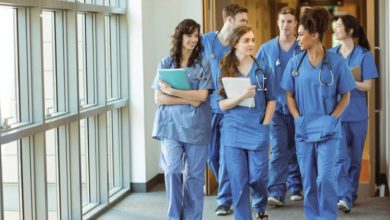
What is the role of clinical rotations in medical school?
The medical school curriculum is divided into basic science and clinical medicine classes. Basic science covers the fundamental concepts in medicine and lays the foundation for clinical medicine and clinical medicine helps students get adequate practice and experience in medical subjects.
The Doctor of Medicine (M.D.) program, which lasts for ten semesters, includes clinical rotations and is followed by a medical residency. Clinical rotations give you an idea about what you want to specialize in moving forward.
Both basic science and clinical medicine carry equal significance in the medical curriculum, but clinical rotations give medical students exposure to working in hospital settings. To learn how, let’s analyze the roles and responsibilities of clinical rotations in medical school.
What are clinical rotations?
Clinical rotations are undertaken during semesters six to ten of the Doctor of Medicine (MD) program. During this period, medical students are placed in various hospitals to apply what they have learned in basic science classes in real-life scenarios. As a student doing rotations, you will be allowed to interact directly with patients, diagnose their diseases, and suggest treatments. All of this will be performed under the guidance and supervision of experienced doctors.
Clinical rotations consist of core and elective rotations. Out of the 72 weeks, 42 are dedicated to core rotations and 30 to elective rotations. Core rotations cover common topics such as internal medicine, surgery, pediatrics, obstetrics, gynecology, and psychiatry. Elective rotations allow you to pursue any specialization of your choice.
What are the roles of clinical rotations?
Clinical rotations are all about gaining practice and experience and learning new lessons which basic science could not teach you. Basic science teaches you the theoretical side of medicine and medicinal terms. This is foundational knowledge required for practical lessons. Let’s go through the main responsibilities of clinical rotations in medical school:
- Clinical rotations help build physical examination skills in students who will be asked to diagnose patients and given responsibilities of direct patient care.
- Students will learn to manage common diseases and will understand the use of various diagnostic procedures.
- It introduces students to the procedures in the operating room and allows them to assist in several surgeries and post-surgical care procedures.
- Clinical rotations teach them the procedures of prenatal care and delivery along with the physical diagnosis of diseases in infants.
- Various lessons about psychiatry and the judicious use of treatments and medications are also taught during rotations.
- Elective rotations give you time to contemplate and choose your area of specialization for the future.
- Apart from medical lessons, clinical rotations test you and teach you professional values and ethics to be followed during your practice as a doctor.
Though clinical rotations can be tough and challenging, especially the sudden shift from classroom settings to real hospitals, it presents opportunities to learn and apply your knowledge to patient care and diagnosis. Besides, you will receive help from your peers and mentors which will make the whole MD journey worth it.





